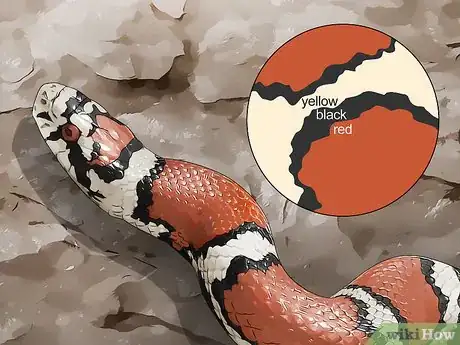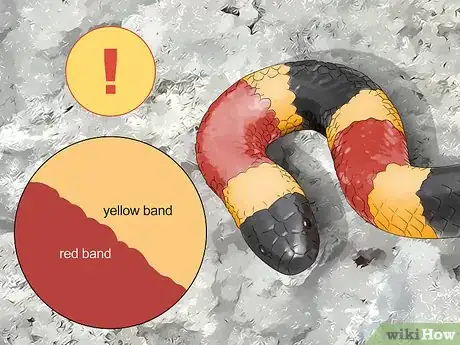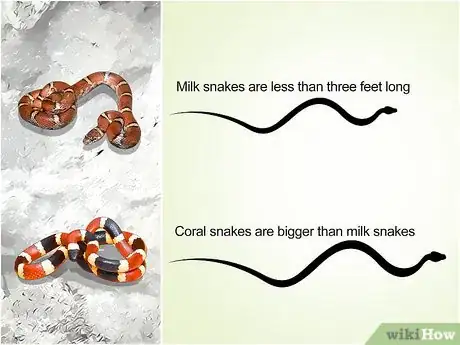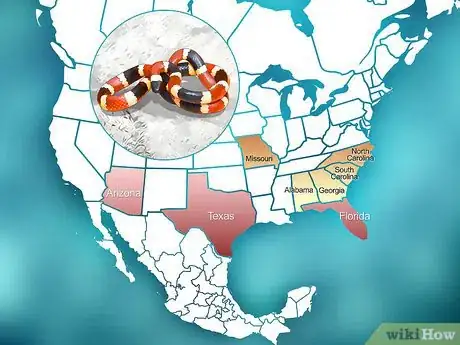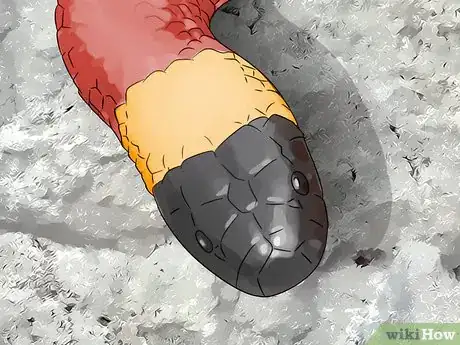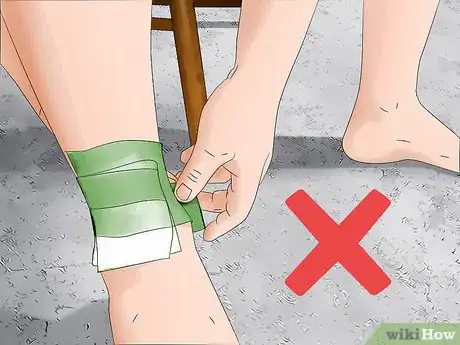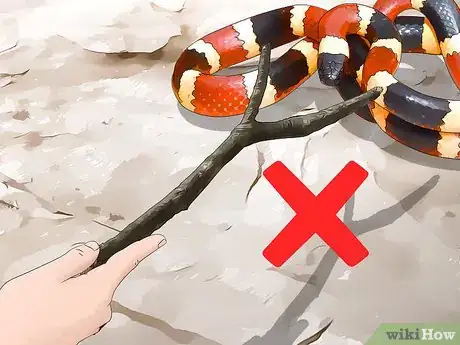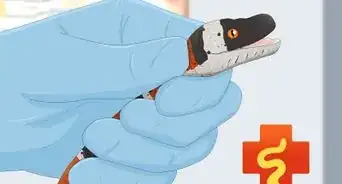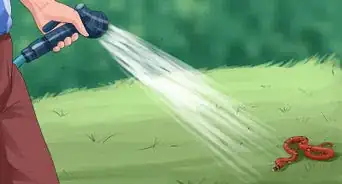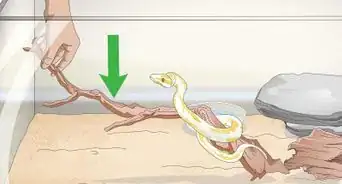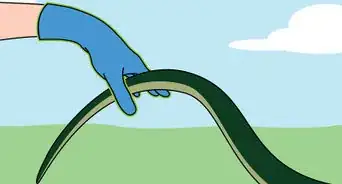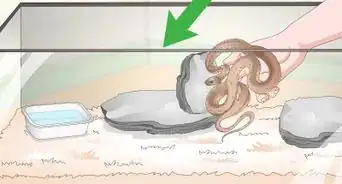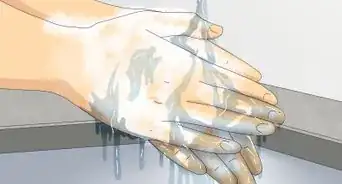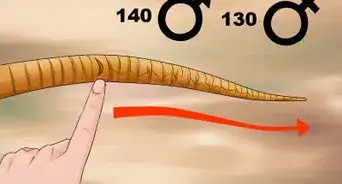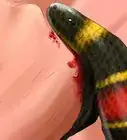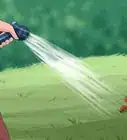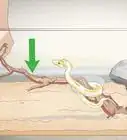This article was co-authored by wikiHow Staff. Our trained team of editors and researchers validate articles for accuracy and comprehensiveness. wikiHow's Content Management Team carefully monitors the work from our editorial staff to ensure that each article is backed by trusted research and meets our high quality standards.
wikiHow marks an article as reader-approved once it receives enough positive feedback. In this case, 92% of readers who voted found the article helpful, earning it our reader-approved status.
This article has been viewed 111,784 times.
Learn more...
Coral snakes and milk snakes look alike. However, it's important to know the difference, as coral snakes are venomous. The easiest way to distinguish between a coral snake and a milk snake is the color of its stripes. You can also look at the snake's size and the color of a snake's face. If you are bitten by a snake, seek medical attention immediately. Even if you are not experiencing symptoms of poisoning, you should still be evaluated by a doctor.
Steps
Checking the Colors
-
1Check for stripes versus blotches. The differences in stripe patterns are typically used to tell the difference between milk and coral snakes. However, some milk snakes do not have stripes. If you notice a snake with blotches instead of stripes, it's more likely to be a milk snake.[1]
- However, do not assume a snake is not venomous simply because it has blotches. You should still stay away from a wild snake to avoid getting bitten.
-
2Look at whether black rings separate red and yellow rings. Both corral snakes and milk snakes contain black, yellow, and red splotches. With milk snakes, there will be a black ring between red and yellow rings. The red and yellow rings will not touch on a milk snake.[2]Advertisement
-
3See if the red bands touch the yellow bands. If red and yellow bands are touching, this is a bad sign, you are probably looking at a coral snake, which is venomous. You should stay away from snakes that have red and yellow stripes that touch.[3]
- Be careful in areas with leaf piles or burrows. Coral snakes tend to hide in such areas.
Looking at Other Factors
-
1Examine the size of the snake. Milk snakes generally tend to be smaller than coral snakes. Most milk snakes are less than three feet long. However, if you live in Honduras, some milk snakes can grow as long as 5 feet in length.[4]
-
2Think about your own location. Coral snakes are typically only found in three regions in the United States. Therefore, you're unlikely to find a coral snake if you don't live in those areas.[5]
- Coral snakes can live in Arizona and certain parts of Texas.
- Coral snakes can also live around Florida and its bordering states. Coral snakes may live in Florida, Georgia, Missouri, Alabama, South Carolina, and North Carolina.
-
3Look at the snake's face. Coral snakes have a solid black face. There will be a yellow band directly below the solid black marking on the face. It may be difficult to see a coral snake's eyes due to the coloring on the face.[6]
Keeping Safe from Venomous Snakes
-
1Be aware of the symptoms of snake bite. While you will usually be aware if a snake bites you, a young child or animal may not be able to tell you they were bitten. Make sure you know the symptom of a snake bite, especially if you live in an area that has poisonous snakes. Symptoms include:[7]
- A puncture wound with redness and swelling surrounding it
- Labored breathing
- Nausea or vomiting
-
2Seek medical attention immediately for a snake bite. Even if you're not experiencing symptoms like pain or swelling, you should always seek medical help in the event of a snake bite. You should call 9-1-1 or the emergency services in your area. A worker should instruct you whether to come into the emergency room or make an appointment with your doctor as soon as possible.[8]
-
3Do not attempt to treat the wound alone. You should never attempt to make a tourniquet, slash the wound with a knife, or do any other treatments on your own. You should always seek out professional medical help in the event of a snake bite.[9]
-
4Avoid attempting to trap the snake. Most snakes will not attack you unprovoked and are not dangerous, even if they are venomous. If your'e concerned about poisonous snakes in your area, contact animal control. Do not attempt to trap or kill a snake on your own. Not only can this be dangerous, it may be illegal in your area.[10]
References
- ↑ http://animals.mom.me/similarities-between-coral-snakes-milk-snakes-8154.html
- ↑ http://animals.mom.me/similarities-between-coral-snakes-milk-snakes-8154.html
- ↑ https://www.cdc.gov/niosh/topics/snakes/types.html
- ↑ http://animals.mom.me/similarities-between-coral-snakes-milk-snakes-8154.html
- ↑ https://snakebuddies.net/2010/09/03/red-and-yellow-kills-a-fellow-your-identification-guide-to-tri-color-snakes/
- ↑ https://snakebuddies.net/2010/09/03/red-and-yellow-kills-a-fellow-your-identification-guide-to-tri-color-snakes/
- ↑ https://www.cdc.gov/niosh/topics/snakes/symptoms.html
- ↑ https://www.cdc.gov/niosh/topics/snakes/symptoms.html
- ↑ https://www.cdc.gov/niosh/topics/snakes/symptoms.html
About This Article
It’s important to tell the difference between coral and milk snakes, since coral snakes are venomous. Although they look similar, milk snakes tend to have blotches instead of stripes and they’re generally under 3 feet long outside of Honduras. Milk snakes also have black patches or rings between red and yellow. If you spot red and yellow next to each other, it’s probably a coral snake. You can remember this with the rhyme, “Red on black, friend of Jack. Red on yellow, you're a dead fellow.” In the U.S., coral snakes are typically only found in Arizona, some parts of Texas, and around Florida and its bordering states. Always be careful if you notice a snake, and keep your distance just in case. If you’re bitten by a snake, call 911 immediately, even if you don’t have any symptoms of a venomous bite. For more tips, including how to get rid of a snake in your area, read on!

